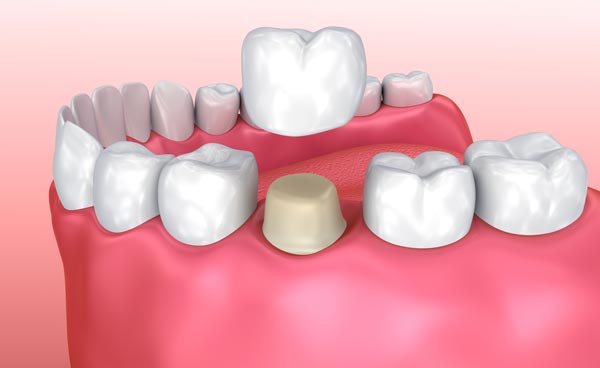Dental Crowns
 Dental crowns are a strong and natural looking solution to protecting and improving damaged teeth. A dental crown is a custom made cover that fits over a damaged, decayed or unattractive tooth. A dental crown can also replace an entire tooth as part of dental bridgework.
Dental crowns are a strong and natural looking solution to protecting and improving damaged teeth. A dental crown is a custom made cover that fits over a damaged, decayed or unattractive tooth. A dental crown can also replace an entire tooth as part of dental bridgework.
Dental crowns cover teeth completely to the gum line. This sets them apart from porcelain veneers, which only cover the front of the tooth. While porcelain veneers need a natural, healthy tooth to be placed on, dental crowns can restore a tooth that is missing a large amount of structure above the gum line. This allows dental crowns to strengthen teeth.
The dental crowns can be crafted from a few different materials. If appearance is the main quality you would like to improve, a high-tech porcelain material might be the option for you. It closely resembles natural teeth to give you a bright smile. If you need something extra strong and durable, cast gold is another option. However, this might not be the best aesthetic choice, especially for front teeth. Thus, there are porcelain-fused-to-metal (PFM) crowns. These are strong, while keeping the porcelain exterior for that bright white smile. If you would like to contact us, we would be happy to discuss the pros and cons of each material with you.
Crowning or Capping a Tooth
It will take two to three visits to apply a dental crown. During the first visit, the tooth must be prepared. It will be shaped to fit inside the dental crown. This will require either drilling or filling material, depending on the amount of tooth structure, to create a uniform shape to support the dental crown.
After the tooth has been prepared, an impression is created. This can be made digitally or with putty-like impression materials. These will then be sent to the dental laboratory where models of you teeth are made. The models will then be used by skilled technicians to create a dental crown that will enhance your smile and bite.
After having your tooth reshaped, a temporary crown will be attached. This will protect your teeth until the permanent dental crown has been prepared. At your second visit the permanent dental crown will be attached with either a resin that hardens under a special light source, or a type of permanent cement.
Creating a Bridge
If you are completely missing a tooth, dental crowns may be a solution. A bridgework is created to span the space of the missing tooth. This requires at least three crowns. Two will be placed on the abutment teeth, or healthy teeth that surround the missing tooth. These become supports for where the third crown will be placed, called the pontic. If multiple teeth are missing more crowns are required to create a strong bridge between the abutment teeth.
The number of abutment teeth necessary to replace missing teeth is directly influenced by the number of missing teeth, where they are located, the amount of bone support each abutment tooth has, and the size and length of the abutment tooth roots. If there are, three missing teeth, you may need four abutment teeth in order to create a strong seven-tooth bridge. The designing and engineering of the bridge requires an understanding of how to replace teeth and the biology of the supporting gum and bone tissue.
Caring for your Dental Crowns
Dental crowns and bridgework require the same care as your natural teeth. Daily brushing and flossing your teeth reduces the buildup of plaque. Maintain your routine visits to the dentist, especially to have the dental crowns checked on. If you have grinding or clenching habits, an investment in a nightguard would be a great solution.
For more information on dental crowns, call Guest, Guest & Guest at (423) 247-2151 or send us a message today!

